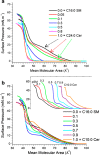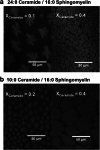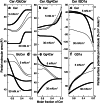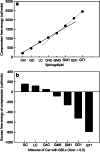The many faces (and phases) of ceramide and sphingomyelin II - binary mixtures
- PMID: 28823080
- PMCID: PMC5662040
- DOI: 10.1007/s12551-017-0298-y
The many faces (and phases) of ceramide and sphingomyelin II - binary mixtures
Abstract
A rather widespread idea on the functional importance of sphingolipids in cell membranes refers to the occurrence of ordered domains enriched in sphingomyelin and ceramide that are largely assumed to exist irrespective of the type of N-acyl chain in the sphingolipid. Ceramides and sphingomyelins are the simplest kind of two-chained sphingolipids and show a variety of species, depending on the fatty acyl chain length, hydroxylation, and unsaturation. Abundant evidences have shown that variations of the N-acyl chain length in ceramides and sphingomyelins markedly affect their phase state, interfacial elasticity, surface topography, electrostatics, and miscibility, and that even the usually conceived "condensed" sphingolipids and many of their mixtures may exhibit liquid-like expanded states. Their lateral miscibility properties are subtlety regulated by those chemical differences. Even between ceramides with different acyl chain length, their partial miscibility is responsible for a rich two-dimensional structural variety that impacts on the membrane properties at the mesoscale level. In this review, we will discuss the miscibility properties of ceramide, sphingomyelin, and glycosphingolipids that differ in their N-acyl or oligosaccharide chains. This work is a second part that accompanies a previous overview of the properties of membranes formed by pure ceramides or sphingomyelins, which is also included in this Special Issue.
Keywords: Brewster angle microscopy; Compression isotherms; Langmuir films; Phase diagrams; Surface miscibility.
Conflict of interest statement
María Laura Fanani declares that she has no conflicts of interest. Bruno Maggio declares that he has no conflicts of interest.
Figures









Similar articles
-
The many faces (and phases) of ceramide and sphingomyelin I - single lipids.Biophys Rev. 2017 Oct;9(5):589-600. doi: 10.1007/s12551-017-0297-z. Epub 2017 Aug 16. Biophys Rev. 2017. PMID: 28815463 Free PMC article. Review.
-
N-Acyl Chain in Ceramide and Sphingomyelin Determines Their Mixing Behavior, Phase State, and Surface Topography in Langmuir Films.J Phys Chem B. 2014 Jul 10;118(27):7475-7487. doi: 10.1021/jp501686q. Epub 2014 Jun 30. J Phys Chem B. 2014. PMID: 24949924
-
Ceramide N-acyl chain length: a determinant of bidimensional transitions, condensed domain morphology, and interfacial thickness.Langmuir. 2011 Apr 5;27(7):3783-91. doi: 10.1021/la105011x. Epub 2011 Feb 28. Langmuir. 2011. PMID: 21355583
-
Ceramide acyl chain length markedly influences miscibility with palmitoyl sphingomyelin in bilayer membranes.Eur Biophys J. 2010 Jul;39(8):1117-28. doi: 10.1007/s00249-009-0562-6. Epub 2009 Nov 12. Eur Biophys J. 2010. PMID: 19908035
-
Sphingolipids and the formation of sterol-enriched ordered membrane domains.Biochim Biophys Acta. 2006 Dec;1758(12):1945-56. doi: 10.1016/j.bbamem.2006.05.020. Epub 2006 Jun 3. Biochim Biophys Acta. 2006. PMID: 16901461 Review.
Cited by
-
Lipid Self-Assemblies under the Atomic Force Microscope.Int J Mol Sci. 2021 Sep 18;22(18):10085. doi: 10.3390/ijms221810085. Int J Mol Sci. 2021. PMID: 34576248 Free PMC article. Review.
-
Small Molecule Inhibitors Targeting Biosynthesis of Ceramide, the Central Hub of the Sphingolipid Network.J Med Chem. 2021 Jan 14;64(1):279-297. doi: 10.1021/acs.jmedchem.0c01664. Epub 2021 Jan 4. J Med Chem. 2021. PMID: 33395289 Free PMC article. Review.
-
Structural basis for acyl chain control over glycosphingolipid sorting and vesicular trafficking.Cell Rep. 2022 Jul 12;40(2):111063. doi: 10.1016/j.celrep.2022.111063. Cell Rep. 2022. PMID: 35830800 Free PMC article.
References
Publication types
LinkOut - more resources
Full Text Sources
Other Literature Sources

